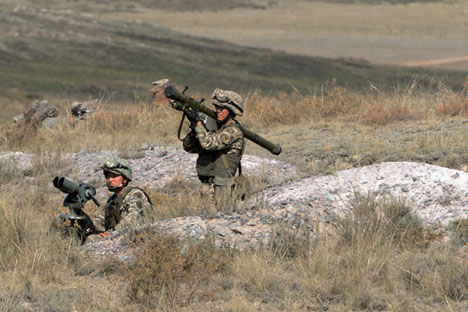
Military servicemen during the Interaction 2014 military drill for the Collective Rapid Reaction Force of the Collective Security Treaty Organization, at the Spassk Training Center in Kazakhstan. Source: Sergey Kuznecov / RIA Novosti
The Verba portable air defense missile system, which was developed within the Instrument Design Bureau (belongs to Vysokotochnye sistemy holding), was integrated into one of the airborne troops divisions and in a motorized infantry brigade in the Eastern Military District.
The newest man-portable air-defense systems (MANPADS) should replace the Igla-S systems of the previous generation that are currently in use.
“The Verba will be delivered not only to the motorized rifle and tank brigades, but also to the Airborne Forces, as well as the Marines. We plan to replace the presently armed Igla air defense system with the new MANPADS,” a Russian Defense Ministry spokesman familiar with the situation told RBTH. However, he was unable to comment on the exact timing of a complete replacement.
The same source told the publication that it is possible that in the near future the new MANPADS will replace the anti-aircraft defense arsenal, and there will also be models with either wheels or a tracked chassis.
The Verba can take out drones and cruise missiles
The main difference between the Verba and Russian MANPADS of the last generation is the heat-seeking multispectral optical heating-seeking head (GOS), through which the missile can distinguish a captured target from passive heat traps, which are now required elements in the defense systems of not only fighters, bombers, attack helicopters and attack aircraft, but also transport aircraft and helicopters.
Currently Igla MANPADS are operational in more than 30 countries (in addition to Russia and CIS countries), including: Bulgaria, Serbia, Croatia, Poland, Finland, Vietnam, Singapore, Brazil, Mexico, Venezuela, Peru, Nicaragua, Cuba, India, Germany, Iraq, and Malaysia.
“MANPADS with multispectral GOS are now being actively bought by the Armed Forces of the United States and France. That being said, these missiles are not currently being exported,” independent military expert, Anton Lavrov, one of the authors of the book Tanki Avgusta (Tanks of August), told RBTH.
The Verba rocket can see its target in three spectra, so it is able to distinguish a target even when so-called ‘laser projectors’ attempt to blind the GOS MANPADS with their rays. The modern heat seeker can detect and engage targets with low thermal radiation, such as drones and cruise missiles. Not even helicopters with specially mounted devices that reduce the temperature of the engine exhaust are safe from the Verba.
Frontal attack
Most foreign MANPADS operate comfortably only in the course of pursuit, when the aircraft has already flown past the position of the MANPADS operator, and the missile is fired after it, focusing on the thermal emissions coming from the aircraft’s engines.
However, the Russian Verba with its 9m336 rocket can take the enemy head-on, with a frontal attack. In such a scenario, the multispectral optical heat-seeker does not recognize the heat emitted by the engine of the aircraft, but the heat that builds up on the wings and fuselage from air resistance.
“In addition to its new heat-seeking head, the Russian Verba distinguishes itself from the Igla with its superior performance characteristics, in particular in the range and altitude at which it can hit its target,” the representative of the Russian Defense Ministry said to RBTH.
While the majority of the actual characteristics of modern MANPADS remain tightly guarded, it has been voiced in media reports that the latest Verba rocket is able to hit a target at a distance of 4 miles and at an altitude of 2.8 miles. Its predecessor, the Igla, could reach its target at almost the same distance, but only at a height of 2.2 miles. For the sake of comparison, the radius of the effective action of the American Stinger MANPADS is only 3 miles in distance and 2.4 miles in altitude.
The new MANPADS, using the integrated automated control system (ACS) terminal, can be used both individually and as part of the battery. Through the ACS the commander uses data not only from ground radar, but also, according to some data, even from early radar warning aircraft. It can see its targets in advance, and then distribute them among operators of MANPADS in automatic mode.
“Currently systems with similar performance characteristics, equipped with multispectral optical heat-seeking heads are operational only in the United States and France,” independent military expert Anton Lavrov commented to RBTH. “Foreign systems are also used in combination with an automated troop command system. However, Russia's Verba is still superior to its foreign counterparts in its tactical and technical characteristics.”
All rights reserved by Rossiyskaya Gazeta.
Subscribe
to our newsletter!
Get the week's best stories straight to your inbox